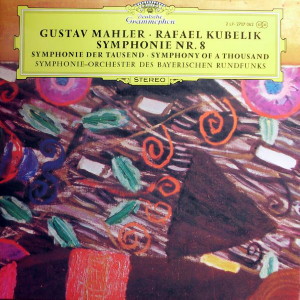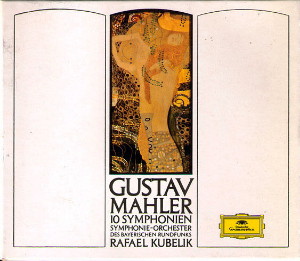 |
|
2 LP's
- 2707 062 - (p) 1971
|
 |
| 10 CD's
- 429 042-2 - (c) 1989 |
|
| GUSTAV
MAHLER (1860-1911) |
|
|
|
|
|
|
|
Symphonie Nr. 8
Es-dur "Symphonie der Tausend"
|
|
73' 39" |
|
Long Playing 1 -
2530 240
|
|
|
|
| -
Teil I - Hymnus "Veni, creator
spiritus" |
21'
53" |
|
|
| -
Teil II (I) - Schluss-Szene aus
"Faust II" |
20' 39" |
|
|
Long Playing 2 -
2530 241
|
|
|
|
| -
Teil II (II) - Schluss-Szene aus
"Faust II" |
19' 39" |
|
|
| -
Teil II (III) - Schluss-Szene aus
"Faust II" |
11' 28" |
|
|
|
|
|
|
| Martina
Arroyo, Sopran I (Magna Peccatrix) |
Chöre
des Bayerischen, Norddeutschen und
Westdeutschen Rundfunks /
Josef Schmidhuver, Helmut Franz,
Herbert Schernus, Einstudierung
|
Erna Spoorenberg,
Sopran II (Mater gloriosa)
|
Knaben des
Regensburger Domchors /
Christoph Lickleder, Einstudierung
|
Edith Mathis,
Sopran III (Una poenitentium)
|
Frauenchor des
Münchener Motettenchors / Hans
Eudolf Zöbeley, Einstudierung
|
Julia Hamari,
Alt/Contralto I (Mulier
Samaritana)
|
Eberhard Kraus, Organ
|
Norma Procter,
Alt II (Maria Aegyptiaca)
|
|
Donald Grobe,
Tenor (Doctor Marianus)
|
Symphonie-Orchester
des Bayerischen Rundfunks |
Dietrich
Fischer-Dieskau, Bariton
(Pater ecstaticus)
|
Rafael KUBELIK |
Franz Crass,
Bass (Pater profundus)
|
|
|
|
|
|
Luogo
e data di registrazione |
|
Kongreß-Saal
des Deutschen Museums, München
(Germania) - giugno 1970
|
|
|
Registrazione:
live / studio |
|
studio |
|
|
Executive
Producer |
|
Wilfried
Daenicke
|
|
|
Artistic
Supervision
|
|
Hans
Weber |
|
|
Recording
Engineer
|
|
Heinz
Wildhagen |
|
|
Prima Edizione
LP |
|
Deutsche
Grammophon - 2707 062 - (2 LP's) -
durata 32' 32" & 31' 07" - (p)
1971 - Analogico |
|
|
Prima Edizione
CD |
|
Deutsche
Grammophon - 429 042-2 - (10
CD's - 9°) - (c) 1989 - ADD
|
|
|
Note |
|
Gustav Klimt
"Salome" (Detail)
|
|
|
|
|
Gustav Mahler's
Eighth Symphony is a work in
a class of
its own. It requires an
uncommonly large performing
apparatus - a huge orchestra
and organ, together with
a double mixed-voice choir,
a children’s choir and eight
soloists. In view of the
vast forces which pack the
platform this work has been
called the Symphony of a
Thousand, and the resources
it demands are certainly
more
extensive than those of any
of Mahler's other
symphonies. It is, however,
perhaps the easiest among
them to
understand. It poses
problems, but provides the
solution to them in musical
terms.
Mahler had good reason for
describing this work as a
symphony rather than, say, a
cantata for soli, chorus
and large orchestra. To him
the concept of the symphony
did not signify merely a
musical form which
existed as the product of a
process of development
spread over centuries; he
saw the symphony as being,
both in form and content,
the medium best suited to
the expression of what he
had to say - universal,
allembracing, and aspiring
towards the cosmic. He
considered the symphony an
ideal meeting place for
spiritual forces, and in
this instance he brought
together two
entirely dissimilar texts -
a medieval Latin hymn and
a dramatic scene from the
2nd part of Goethe's
“Faust’ - thus giving
expression to his conviction
that
his music would reveal
unmistakably the existence
of a
spiritual association of
ideas between the two texts.
The starting point of the
composition was the Latin
hymn “Veni, creator
spiritus!” Mahler had shown
from
the Third Symphony onwards
that to him the concept of
spiritual life and of God
was essentially one of love.
Consequently the first verse
of the hymn, with its appeal
to the Creator Spirit, was
followed by the equally
impassioned plea “Infunde
amorem cordibus!" (Pour
love into our hearts!). This
was love in Mahler's lofty
sense of the word - an
awakening power which
governs
and forms all things.
This hymn was originally
planned as the first
movement
of a symphony in which it
was to be followed by two
inner movements (a Scherzo
and an Adagio) and by a
Finale comprising a second
hymn corresponding to
the first, on the subject of
the birth of Eros. For a
long
time Mahler sought a
suitable text, a poem whose
words
corresponded to his ideas.
Once he had finally found
what he believed to be the
answer in Goethe, he had an
experience similar to that
which had given rise to the
Resurrection Chorale in the
Second Symphony: inspiration
came to him like a sudden
shaft of light, and the
essential structure of the
work which his imagination
had visualized was clear
before him. In the hymn love
has been invoked as the
creative and awakening
force;
here in the mystical closing
scene from “Faust” love reigns as the
mediating power which
progressively
raises, purifies, redeems
and transforms mankind. -
For
a real understanding of the
Eighth Symphony one
should not think in terms of
“Faust”, but should regard
its final scene as having
been transplanted from the
original context of the
poetic drama into a
different work
of art, of which it now
forms an organic part.
The starting point of all
Mahler's music was the lied.
The poems in the collection
“Des Knaben Wunderhorn"
provided the spark which
kindled his creative
imagination. The experience
which moved him so deeply
that it determined the
course of his creative work,
and of his life, originated
with the German folk song
and
Christian mysteries stylized
with a childlike simplicity.
Now in the Eighth Symphony,
written at the height of
his artistic powers and of
his career, he turned back
to
the world of ideas from
which he had originally set
out. He no longer pursued
the old ideas in their
naive,
childlike forms, but
fashioned them into mature
and immensely powerful
musical structures - the
Christian element in the
hymn, and that of German
folksong in association with
Goethe, whose artistry in
this anchorites’
scene represents a supreme
level of sublimated folk
poetry.
The use of this lengthy
scene from “Faust”
necessitated
the abandonment of Mahler's
original four-movement
plan. In actual fact,
however, it did survive,
although in
so disguised a form as to be
scarcely recognizable.
The composition of the scene
from “Faust” is based on a
concealed three-section
structure which may be
regarded as an Andante,
Scherzo and Finale. The hymn
corresponds to the
proportions and principles
of a sonata
form movement, with its main
theme and second, lyrical
theme clearly to the fore as
the principal elements
of the exposition. The
development section and
recapitulation are no less
easily recognizable.
If the composition of the
“Faust” scene is indeed a
disguised three-movement
structure, the layout of the
Symphony as a whole falls
into two main parts, as in
the
Third Symphony, where a
massive first part is
balanced by a second part
consisting of several
shorter
movements.
On the other hand the
thematic construction marks
a
definite change. While their
family relationship to
earlier themes is not to be
denied, the themes of the
Eighth
Symphony are calmer, more
direct, less nervous, less
wayward and excited.
Although not based on
folksong,
they often take on many of
the characteristics of folk
music.
The greater part of the
composition took place
during
the happy and productive
year 1906. Mahler worked at
that time in a fever of
creative enthusiasm, and
with the
sense of obeying a higher
command. The instrumentation
and final preparation of the
score were not, however,
completed until after Mahler
had left Vienna in
1907. The first performance
took place in September
1910, conducted by Mahler
himself in Munich.
Heinrich
Kralik
|
|